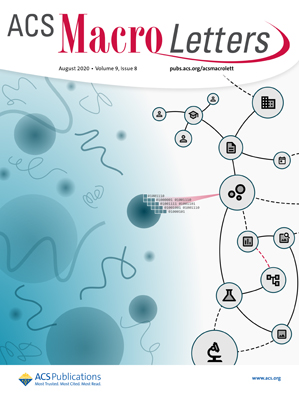Biobased Cyclic Polycarbonate: Synthesis and Applications via Dynamic Bis(hindered amino)disulfide Linkers
IF 5.1
Q1 POLYMER SCIENCE
引用次数: 0
Abstract
Cyclic polymers have garnered significant interest due to their unique structure; however, their synthesis remains challenging, often hindered by low yields and limited selectivity. Considering that the cyclization step during the synthesis of cyclic polymers is presumably the most challenging, using a spontaneous and selective cyclization system is ideal. Here, we present a topology transformation from linear to cyclic, which is achieved through the error-checking ability provided by the dynamic covalent bonding between bis(2,2,6,6-tetramethylpiperidin-1-yl)disulfide (BiTEMPS) and its stable radicals with a high bond exchange rate. When applying this method to biobased poly(isosorbide carbonate) (PIC), an attractive alternative to conventional petroleum-based polycarbonates, high-molecular-weight cyclic polymers were unexpectedly obtained. Since the functionalization of PICs has been traditionally limited to copolymerization techniques, we aimed to introduce dynamic covalent bonds to establish novel functionalization methods for PICs. Interestingly, the synthesis of cyclic PICs through intramolecular cyclization using dynamic covalent bonds in a heterogeneous system proceeded via a ring-expansion polymerization-like mechanism, affording high-molecular-weight cyclic polymers consisting of a PIC backbone and BiTEMPS units as dynamic units. The resulting PIC-based cyclic polymers with BiTEMPS units were applied to bond exchange reactions, providing an effective approach for the synthesis of cyclic block polymers and end-functionalized linear block polymers with a PIC skeleton. These results demonstrate the potential of dynamic covalent chemistry in polymer synthesis.

生物基环状聚碳酸酯:动态双(受阻氨基)二硫连接体的合成与应用
环状聚合物由于其独特的结构而获得了极大的兴趣;然而,它们的合成仍然具有挑战性,通常受到低收率和有限选择性的阻碍。考虑到环状聚合物合成过程中的环化步骤可能是最具挑战性的,使用自发和选择性环化系统是理想的。在这里,我们提出了一种从线性到循环的拓扑转换,这是通过双(2,2,6,6-四甲基哌啶-1-酰基)二硫化物(BiTEMPS)与其具有高键交换率的稳定自由基之间的动态共价键提供的错误检查能力来实现的。当将该方法应用于生物基聚异山梨酯(PIC)(传统石油基聚碳酸酯的一种有吸引力的替代品)时,意外地获得了高分子量的环状聚合物。由于PICs的功能化传统上仅限于共聚技术,我们的目标是引入动态共价键来建立新的PICs功能化方法。有趣的是,在非均相体系中,利用动态共价键通过分子内环化合成环状PICs的过程是通过类似环扩张聚合的机制进行的,从而获得了由PIC主链和BiTEMPS单元作为动态单元组成的高分子量环状聚合物。将合成的BiTEMPS环嵌段聚合物应用于键交换反应,为合成环嵌段聚合物和末端功能化的环嵌段聚合物提供了有效途径。这些结果显示了动态共价化学在聚合物合成中的潜力。
本文章由计算机程序翻译,如有差异,请以英文原文为准。
求助全文
约1分钟内获得全文
求助全文
来源期刊
CiteScore
10.40
自引率
3.40%
发文量
209
审稿时长
1 months
期刊介绍:
ACS Macro Letters publishes research in all areas of contemporary soft matter science in which macromolecules play a key role, including nanotechnology, self-assembly, supramolecular chemistry, biomaterials, energy generation and storage, and renewable/sustainable materials. Submissions to ACS Macro Letters should justify clearly the rapid disclosure of the key elements of the study. The scope of the journal includes high-impact research of broad interest in all areas of polymer science and engineering, including cross-disciplinary research that interfaces with polymer science.
With the launch of ACS Macro Letters, all Communications that were formerly published in Macromolecules and Biomacromolecules will be published as Letters in ACS Macro Letters.

 求助内容:
求助内容: 应助结果提醒方式:
应助结果提醒方式:


